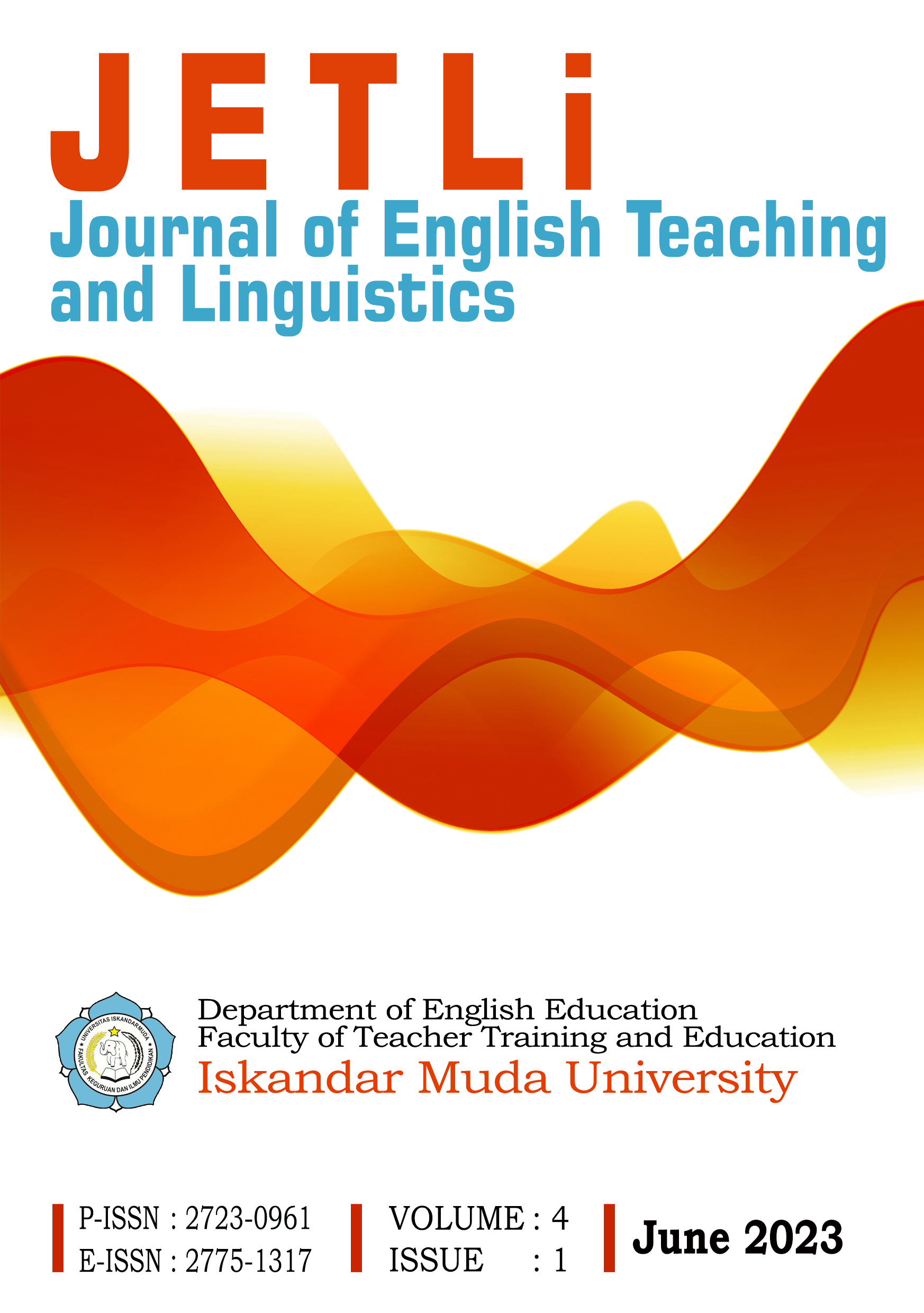Oral Corrective Feedback in EFL Classroom
DOI:
https://doi.org/10.55616/jetli.v4i1.552Keywords:
EFL Classroom Interaction,, Feedback,, Recast, ElicitationAbstract
Feedback is the most essential part in EFL (English as Foreign Language) teaching and learning process. At this stage, students speaking is evaluated so that they know the progress of their learning. This study is aimed at examining the application of teachers’ corrective feedback in classroom interactions. The research used qualitative methods and it used observation sheets and audio recorders. The writer collected data through observations to generate the main data and through interviews to support the primary data. The sample for this study consisted of 34 students and two English teachers. Data were analyzed by a qualitative procedure based on the Mile and Huberman (2013) model. This includes data reduction, data display, and inference. Results showed that the most common corrective feedback used by teachers in classroom interactions was recast, occurring 66.7% or 64 times in the class. Interviews revealed that there were three reasons for using corrective feedback are to help students avoid mistakes; to improve students' grammar, vocabulary, and pronunciation; and to motivate students to learn English better
References
Ahangari, S., & Amirzadeh, S. (2011). Exploring the teachers’ use of spoken corrective feedback in teaching Iranian EFL learners at different levels of proficiency. Procedia-Social and Behavioural Sciences, 29, 1859-1868
Allwright, D & Bailey, K.M. (1991). Focus on the Language Classroom. Cambridge: Cambridge University Press
Alsubaie, S. (2015). An analysis of classroom discourse: Elicitation techniques in EFL classroom. International Journal of English Language Teaching. 3(8), 29-39
Arikunto, S. (2006). Prosedur Penelitian Suatu Pendekatan Praktik. Jakarta: Rineka Cipta
Asari, Y. (2015). How To Effectively Provide Recasts in Foreign Language Classrooms. Dialogue, 13, 1-9.
Ayouni, N., & El-Sukny, M. (2022). An Analysis on Elicitation as Corrective Feedback to Students’ Grammar Errors. Journal of English Teaching and Linguistics, 3(2), 109-115. https://doi.org/10.55616/jetli.v3i2.393
Azmi, F. (2018). An Analysis on Teacher’s Feedback in Speaking Class, A Descriptive Study at Ar-Raniry State University. (Unpublished Thesis). Syiah Kuala University, Banda Aceh, Indonesia
Black, K. (2010). Business Statistics for Contemporary Decision Making. USA: Wiley Inc.
Bogdan, R. C & Biklen, S.K. (1992). Qualitative Research for Education. USA: Allyn and Bacon.
Brown, H. D. (2001). Teaching By Principles: An Interactive Approach to Language Pedagogy. New York: Longman.
Buchari, K. (2022). Teacher’s Recast and Corrective Feedback In Classroom Interaction. Journal of English Teaching and Linguistics, 3(2), 87-97. https://doi.org/10.55616/jetli.v3i2.339
Burrill, K. (2012). How Useful Are Recasts?: Factors Influencing Their Success And Problems In Testing. Retrieved on November 8, 2018 from www.tc.columbia.edu/tesolalwebjournal
Creswell, J. W. (2009). Research Design: Qualitative, Quantitative, and Mixed Methods Approaches. California: SAGE Publications, Inc.
Chaudron, C. (1998). Second Language Classroom. Cambridge: Cambridge University Press.
Cole, G. P., & Chan, K. S. L. (1997). Teaching Principles and Practice. Australia: Prentice Hall Pty. Ltd.
Coskun, A. (2010). A Classroom Research Study on Oral Error Correction. Humanizing Language Teaching Magazine. 12(3), 1-12
Ellis, R. (1986). Understanding Second Language Acquisition. New York: Oxford University Press
Ellis, R. (2005). Instructed Second Language Acquisition: A Literature Review. New Zealand: Ministry of Education.
Ellis, R. (2009). Corrective Feedback and Teacher Development. L2 Journal, 1(1).
Esmaeili, S.Z & Afshar, M. (2016). The role of recast feedback vs. metalinguistic feeback on second language speaking proficiency. American Internasional Journal of Research in Humanities, Arts and Social Sciences. 17(1), 47 – 53
Fu, T., & Nassaji, H. (2016). Corrective feedback, learner uptake, and feedback perception in a Chinese as a foreign language classroom. Studies in Second Language Learning and Teaching, 6(1), 159-181.
Goh, C.C.M., & Burns A. (2012). Teaching Speaking: A Holistic Approach. USA: Cambridge University Press
Gholizade, R. (2013). The Investigation of Differential Effects of Recast and Metalinguistic Feedback on Accuracy, Fluency, And Complexity of Speaking Performance of Male and Female EFL Learners. Journal of Novel Applied Sciences. 2(9), 417-428
Harmer, J. (2007). The Practice of English Language Teaching (Fourth Edition). New York: Pearson Longman.
Kerr, P. (2017). Giving Feedback on Speaking. Cambridge: Cambridge University Press.
Lee, J. (2007). Corrective Feedback and Learner Uptake in English Immersion Classrooms at The Primary Level in Korea. English Teaching, 62(4), 311-334
Loewen, S., & Nabei, T. (2007). Measuring the effects of oral correction feedback on L2 knowledge. Conversational interaction in second language acquisition: A collection of empirical studies, 361-377
Luoma, S. (2004). Assessing Speaking. Cambridge: Cambridge University Press.
Lyster, R & Ranta, L. (1997). Corrective feedback and learner uptake: Negotiation of form in communicative classrooms. Studies in Second Language Acquisition, 19(1), 37-66.
Yusnida, D. (2020). THE TEACHING LISTENING PROCES AT THE FIRST YEAR STUDENTS OF ENGLISH DEPARTMENT OF UIN AR-RANIRY BANDA ACEH. Journal of English Teaching and Linguistics, 1(2), 114-125. https://doi.org/10.55616/jetli.v1i2.22
Published
How to Cite
Issue
Section

This work is licensed under a Creative Commons Attribution 4.0 International License.
Authors retain copyright and grant the journal right of first publication with the work simultaneously licensed under an Attribution 4.0 International (CC BY 4.0) that allows others to share — copy and redistribute the material in any medium or format and adapt — remix, transform, and build upon the material for any purpose, even commercially with an acknowledgment of the work's authorship and initial publication in this journal.







 Journal of English Teaching and Linguistics
Journal of English Teaching and Linguistics